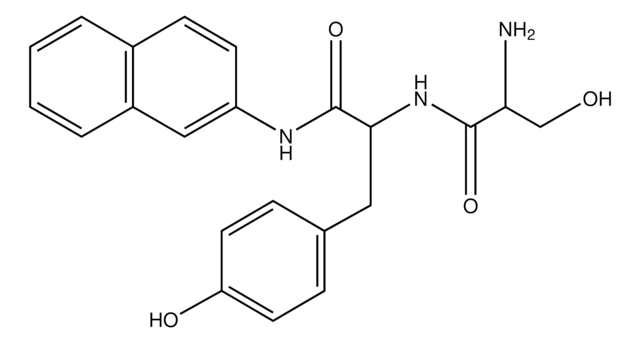14-392
Green Fluorescent Protein
Synonim(y):
GFP
Zaloguj sięWyświetlanie cen organizacyjnych i kontraktowych
About This Item
Kod UNSPSC:
12352200
eCl@ss:
32160405
NACRES:
NA.32
Polecane produkty
Opis ogólny
N-terminal HIS-tagged fusion protein corresponding to full-length Green Fluorescent Protein, expressed in E. coli. Green fluorescent protein (GFP) is a cytoplasmic protein found in jellyfish Aequorea Victoria.
Działania biochem./fizjol.
Green fluorescent protein (GFP) is genetically fused to many proteins in various species to generate non-reactive chimeras which are known to preserve their original biological activity as well as the fluorescent properties of native GFP. GFP acts as a reporter for gene expression and as a fusion tag for protein localization studies in live cells. It serves as a spectroscopic and microscopic probe to understand the biological functions of various systems. GFP is highly stable and can serve as a tool for in vitro studies.
Jakość
Routinely evaluated as a standard on protein gels and western immunoblots, for calibration of fluorometers, and microinjection into cells and tissues.
Postać fizyczna
PBS containing 20% glycerol.
Przechowywanie i stabilność
1 year at -20°C
Informacje prawne
GenBank is a registered trademark of United States Department of Health and Human Services
UPSTATE is a registered trademark of Merck KGaA, Darmstadt, Germany
Oświadczenie o zrzeczeniu się odpowiedzialności
Unless otherwise stated in our catalog or other company documentation accompanying the product(s), our products are intended for research use only and are not to be used for any other purpose, which includes but is not limited to, unauthorized commercial uses, in vitro diagnostic uses, ex vivo or in vivo therapeutic uses or any type of consumption or application to humans or animals.
This page may contain text that has been machine translated.
Kod klasy składowania
10 - Combustible liquids
Klasa zagrożenia wodnego (WGK)
WGK 2
Temperatura zapłonu (°F)
Not applicable
Temperatura zapłonu (°C)
Not applicable
Certyfikaty analizy (CoA)
Poszukaj Certyfikaty analizy (CoA), wpisując numer partii/serii produktów. Numery serii i partii można znaleźć na etykiecie produktu po słowach „seria” lub „partia”.
Masz już ten produkt?
Dokumenty związane z niedawno zakupionymi produktami zostały zamieszczone w Bibliotece dokumentów.
Klienci oglądali również te produkty
Sonit Kumar Gogoi et al.
Langmuir : the ACS journal of surfaces and colloids, 22(22), 9322-9328 (2006-10-18)
Recombinant Escherichia coli (E. coli) bacteria expressing green fluorescent protein (GFP) was used as a model system to investigate the antimicrobial activities of Ag nanoparticles (NPs). A convenient in situ method of Ag NP synthesis using sodium borohydride, in the
Vincent Jung et al.
Proteomics, 22(9), e2100031-e2100031 (2021-12-28)
Biolayer interferometry (BLI) is a technology which allows to study the affinity between two interacting macro-molecules and to visualize their kinetic of interaction in real time. In this work, we combine BLI interaction measurement with mass spectrometry in order to
Dominique C S Evans et al.
Microbial cell (Graz, Austria), 10(7), 145-156 (2023-07-03)
Staphylococcus aureus is a major human pathogen that utilises many surface-associated and secreted proteins to form biofilms and cause disease. However, our understanding of these processes is limited by challenges of using fluorescent protein reporters in their native environment, because
Sebastian Strauss et al.
Nature methods, 15(9), 685-688 (2018-08-22)
Although current implementations of super-resolution microscopy are technically approaching true molecular-scale resolution, this has not translated to imaging of biological specimens, because of the large size of conventional affinity reagents. Here we introduce slow off-rate modified aptamers (SOMAmers) as small
Elisa M York et al.
Biomedical optics express, 10(9), 4381-4394 (2019-10-01)
Autofluorescence of endogenous molecules can provide valuable insights in both basic research and clinical applications. One such technique is fluorescence lifetime imaging (FLIM) of NAD(P)H, which serves as a correlate of glycolysis and electron transport chain rates in metabolically active
Nasz zespół naukowców ma doświadczenie we wszystkich obszarach badań, w tym w naukach przyrodniczych, materiałoznawstwie, syntezie chemicznej, chromatografii, analityce i wielu innych dziedzinach.
Skontaktuj się z zespołem ds. pomocy technicznej









